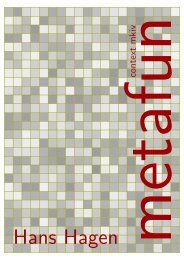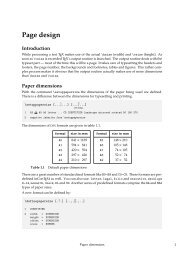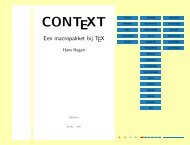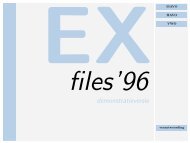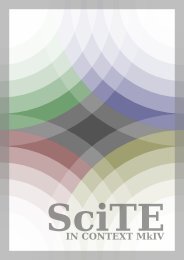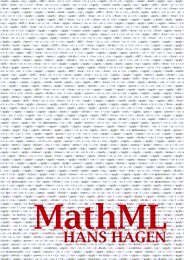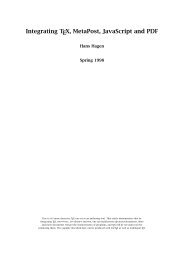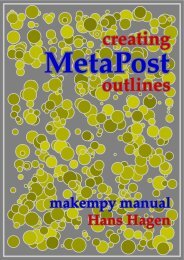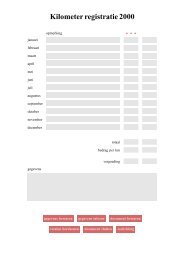Hagen - Pragma ADE
Hagen - Pragma ADE
Hagen - Pragma ADE
Create successful ePaper yourself
Turn your PDF publications into a flip-book with our unique Google optimized e-Paper software.
10<br />
Font formats<br />
When T E X ships out a page, the backend will load the real font data and merge that<br />
into the final output. It will now take the glyph index and build the right data structures<br />
and references to the real font. As a font gets subset only the used glyphs end up in the<br />
final output.<br />
There is one tricky aspect involved here: re-encoding. In so called map files one can<br />
map a specific metric filename onto a real font name. One can also specify an encoding<br />
vector that tells what a given index really refers to. This makes it possible to use fonts<br />
that have more than 256 glyphs and refer to any of them. This is also the trick that<br />
makes it possible to use TrueType fonts in pdfT E X: the backend code filters the right<br />
glyphs from the font, remapping T E X’s glyph indices onto real entries in the font happens<br />
via the encoding vector. In figure 1.6 we show a possible route for input byte 68.<br />
bytes (68) bytes (31) index (31) index (88)<br />
Figure 1.6 From bytes to indices.<br />
As LuaT E X carries much of the bagage of older engines, you can still do it this way but<br />
in ConT E Xt MkIV we have made our live much simpler: we use unicode as much as<br />
possible. This means that we effectively have removed two steps (see figure 1.7).<br />
input glyphs<br />
Figure 1.7 Simplified<br />
mapping in LuaT E X.<br />
There is of course still some work to do for the backend, like subsetting, but the nasty<br />
dependency on the input encoding, font encoding (that itself relates to hyphenation) and<br />
backend re-encoding is gone. But keep in mind that the internal data structure of the<br />
font is still quite traditional.<br />
Before we move on to font formats I like to point out that there is no space in T E X.<br />
Spaces in the input are converted into glue, either or not with some stretch and/or<br />
shrink. This also means that accessing character 32 in traditional T E X will not end up<br />
as space in the output.<br />
1.4 T E X metrics<br />
A.2<br />
A.1 Traditional font metrics are packaged in a binary format. Due to the limitations of that<br />
time a font has at most 256 characters. In books dedicated to T E X you will often find<br />
tables that show what glyphs are in a font, so we will not repeat that here as after all<br />
we got rid of that limitation in LuaT E X.<br />
Because 256 is not that much, especially when you mix many scripts and need lots<br />
of symbols from the same font, there are quite some encodings used in traditional T E X,<br />
like texnansi, ec and qx. When you use LuaT E X exclusively you can do with way less<br />
font files. This is easier for users, especially because most of those files were never used



